Numbers Say Real Madrid's Hot Start Bodes Well For EuroLeague Champs
Numbers Say Real Madrid's Hot Start Bodes Well For EuroLeague Champs
Real Madrid may not have Luka Doncic, but the numbers say their hot early start is a sign of good things to come.

Last week, we looked at the significance of an NBA team’s performance during the beginning of the season to see just how panicked we should be about the slow start of several big-name teams — wink wink, Lakers and Thunder. As Halloween has come and gone, we thought it might be interesting to do a comparison across seas to see if slow starts have the same significance in the EuroLeague.
In order to do this, I regressed each team’s month-by-month record over the past four seasons against their final record to see how early we can really declare a team’s record as “for real.” For historical seasons, I only used teams which made it to the Final 16 so that the total number of games stayed relatively constant. Even so, because the sample size of games was so much smaller than the NBA and variable across seasons, I elected to use percent as opposed to just total wins and losses.
First, let’s look at how much we can know by the end of October.

As you can see from the chart, there does appear to be a significant and upward trending association between a EuroLeague team’s win percentage through October and their win percentage at the end of the season. While there have been teams that have started the season undefeated but ultimately ended with a sub-.500 record, for the most part it looks like teams that start strong will finish strong.
The regression numbers back this up, with an R^2 value of 0.364, meaning that 36 percent of the variation in win percentage at the end of the season can be explained by the win percentage in October. This is significantly larger than the 0.223 R^2 value of October wins in the NBA. This makes sense given the shorter length of the EuroLeague season. Fewer total games mean that the four or five played in October count that much more.
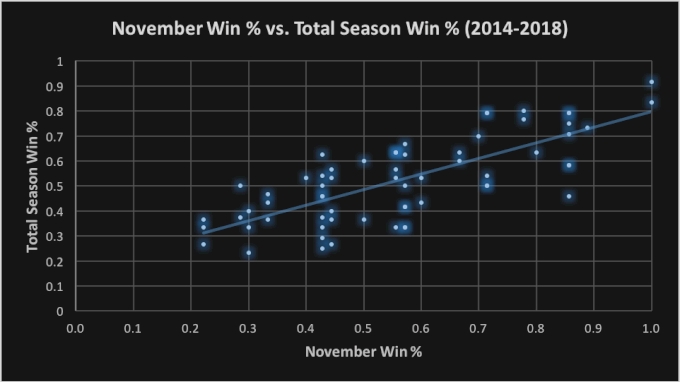
You can see this trend continuing through November; final team win percentages rarely stray more than 10-20 percent from their percentage by the end of October. And while both the slope of the trend line and the strength of the association do appear to increase as the number of games goes up, this change is not nearly as dramatic as that of the NBA. While the NBA R^2 value goes up from 0.223 to 0.686, the EL R^2 only increases from 0.364 to 0.564.
One possible explanation for this is the number of games played during an average full EL month vs an average full NBA month. While teams in the EuroLeague will have played an average of eight games by the end of November, NBA teams will have played an average of 18. Although these make up approximately the same percentage of total games, the 10 more games played in the NBA leave less room for variance.
Finally, we look at what the trend looks like at the end of the calendar year.

As you can see, while the slope of the line remains upward trending, a dot’s average distance from that trend seems to have decreased, indicating that the strength of the association has increased. The R^2 value backs this up, increasing from 0.564 to 0.779. This is nearly identical to the NBA December R^2 value of 0.793.
So what can we make of this comparison? Well, it looks like regardless of whether we’re looking at the NBA or EuroLeague, we should be hesitant to make judgments on any team before the end of December. However, we can be slightly more confident in the hot or slow starts of a EuroLeague team during their first month of play, especially when it comes to teams on either side of the extreme.
Is Real Madrid guaranteed to advance to the playoffs, despite losing reigning MVP Luka Doncic? Certainly not, but the history of 4-0 Octobers is definitely on their side.
Fri Lavey is a writer and consultant who studied economics and statistics at Harvard University. He has previously worked as a data analyst for the NBA, the MLB, and the Philadelphia 76ers.
Related Content
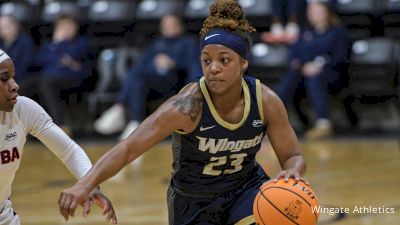 Jaia Wilson Put Up Big Dawg Numbers For Wingate In The SAC Women's Basketball Tournament
Jaia Wilson Put Up Big Dawg Numbers For Wingate In The SAC Women's Basketball TournamentApr 24, 2024
 Monmouth Women's Basketball Coach, Ginny Boggess, Mic'ed Up Is Pure Gold
Monmouth Women's Basketball Coach, Ginny Boggess, Mic'ed Up Is Pure GoldApr 22, 2024
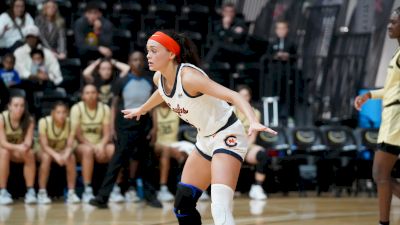 Makayla Alvey Is A Straight Baller For Carson-Newman Women's Basketball
Makayla Alvey Is A Straight Baller For Carson-Newman Women's BasketballApr 18, 2024
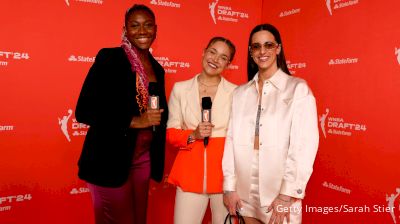 WNBA Draft 2024 Recap: Caitlin Clark Goes No.1 To Indiana Fever
WNBA Draft 2024 Recap: Caitlin Clark Goes No.1 To Indiana FeverApr 16, 2024
 Indiana Fever Roster With No.1 Pick Caitlin Clark Following WNBA Draft
Indiana Fever Roster With No.1 Pick Caitlin Clark Following WNBA DraftApr 15, 2024
 How To Watch The WNBA Draft 2024: Here's What To Know
How To Watch The WNBA Draft 2024: Here's What To KnowApr 11, 2024
 Women's NCAA Basketball Rankings: Way-Too-Early Top 25 for 2024-2025 Season
Women's NCAA Basketball Rankings: Way-Too-Early Top 25 for 2024-2025 SeasonApr 8, 2024
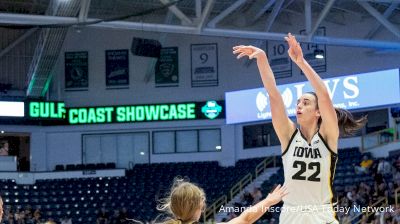 2024 WNBA Mock Draft Post Final Four: Who's After Caitlin Clark at No. 1?
2024 WNBA Mock Draft Post Final Four: Who's After Caitlin Clark at No. 1?Apr 7, 2024
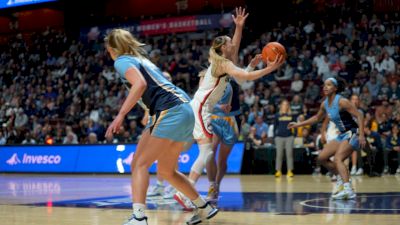 Paige Bueckers And The UConn Huskies Are Final Four Bound
Paige Bueckers And The UConn Huskies Are Final Four BoundApr 4, 2024